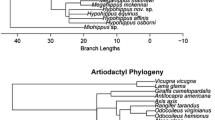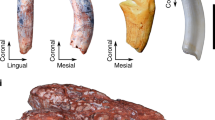Abstract
The evolution of molar teeth from low-crowned (brachyodont) to high-crowned (hypsodont) has traditionally been recognized as a response to increasing tooth wear due to endogenous (e.g., fiber, silica) and/ or exogenous (e.g., dust, grit) properties of ingested food. Recent work indicates that the mean hypsodonty level of large herbivorous land mammalian communities is a strong predictor of precipitation in their habitats. For small mammals, however, the research is still in an early stage. This study performed comparative studies of hypsodonty on 26 extant dipodid species with and without consideration of phylogeny. The results confirm the role of diet in shaping the cheek tooth crown height in Dipodidae. The significant relationship of investigated environmental variables with hypsodonty may be partly due to phylogenetic effects. Nonetheless, the mean hypsodonty of dipodid communities has significant relationship with regional climatic variables. Hence, the hypsodonty of dipodids also has great potential to be a regional climate proxy.





Similar content being viewed by others
References
Axmacher H, Hofmann RR (1988) Morphological characteristics of the masseter muscle of 22 ruminant species. J Zool 215:463–473
Bargo MS, De Iuliis G, Vizcaíno SF (2006) Hypsodonty in Pleistocene ground sloths. Acta Palaeontol Pol 51: 53–61
Benton MJ (2009) The Red Queen and the Court Jester: species diversity and the role of biotic and abiotic factors through time. Science 323:728–732. doi:10.1126/science.1157719
Bivand R, Piras G (2015) Comparing Implementations of Estimation Methods for Spatial Econometrics. J Stat Softw 63: 1–36. . URL http://www.jstatsoft.org/v63/i18/
Blomberg SP, Garland T, Ives AR (2003) Testing for phylogenetic signal in comparative data: behavioral traits are more labile. Evolution 57:717–745. doi:10.1111/j.0014-3820.2003.tb00285.x
Clark EL, Munkhbat J, Dulamtseren S, Baillie JEM, Batsaikhan N, King SRB, Samiya R, Stubbe M (compilers and editors) (2006) Summary Conservation Action Plans for Mongolian Mammals. Regional Red List Series, vol. 2. Zoological Society of London, London
Damuth J, Fortelius M, Andrews P, Badgley C, Hadly EA, Hixon S, Janis C, Madden RH, Reed K, Smith FA, Theodor J, Van Dam JA, Van Valkenburgh B, Werdelin L (2002) Reconstructing mean annual precipitation based on mammalian dental morphology and local species richness. J Vertebr Paleontol 22 (suppl. to no. 3): 48 A
Damuth J, Janis CM (2011) On the relationship between hypsodonty and feeding ecology in ungulate mammals, and its utility in palaeoecology. Biol Rev 86:733–758. doi:10.1111/j.1469-185x.2011.00176.x
Eronen JT, Puolamäki K, Liu L, Lintulaakso K, Damuth J, Janis, Fortelius M (2010a) Precipitation and large herbivorous mammals I: estimates from present-day communities. Evol Ecol Res 12: 217–233
Eronen JT, Puolamäki K, Liu L, Lintulaakso K, Damuth J, Janis, Fortelius M (2010b) Precipitation and large herbivorous mammals II: application to fossil data. Evol Ecol Res 12: 235–248
Felsenstein J (1985) Phylogenies and the comparative method. Am Nat 125:1–15
Fortelius M, Eronen J, Jernvall J, Liu L, Pushkina D, Rinne J, Tesakov A, Vislobokova I, Zhang Z, Zhou L ( 2002) Fossil mammals resolve regional patterns of Eurasian climate change over 20 million years. Evol Ecol Res 4: 1005–1016
Garland T, Bennett AF, Rezende EL (2005) Phylogenetic approaches in comparative physiology. J Exp Biol 208: 3015–3035. doi:10.1242/jeb.01745
Gavrilets S, Losos JB (2009) Adaptive radiation: contrasting theory with data. Science 323:732–737. doi:10.1126/science.1157966
Grafen A (1989) The phylogenetic regression. Phil Trans R Soc Lond B 326: 119–157
Gromov VS (2002) On the biology of five-toed pygmy jerboa (Cardiocranius paradoxus Satunin, 1902) in the Ubsu-Nuur Depression. Russ J Ecol 33: 216–219
Harvey PH, Pagel MD (1991) The Comparative Method in Evolutionary Biology. Oxford University Press, Oxford
Hijmans RJ, Cameron SE, Parra JL, Jones PG, Jarvis A (2005) Very high resolution interpolated climate surfaces for global land areas. Internatl J Climatol 25:1965–1978. doi:10.1002/joc.1276
Hijmans RJ, Guarino L, Mathur P (2012) Manual of DIVA-GIS version 7.5. Available on: http://www.diva-gis.org.
Holden ME, Musser GG (2005) Superfamily Dipodoidea. In: Wilson DE, Reeder DM (eds) Mammal Species of the World: A Taxonomic and Geographic Reference, 3rd edn. Johns Hopkins University Press, Baltimore, pp 871–893
Janis C, Fortelius M (1988) On the means whereby mammals achieve increased functional durability of their dentitions, with special reference to limiting factors. Biol Rev 63:197–230
Janis CM (1988) An estimation of tooth volume and hypsodonty indices in ungulate mammals, and the correlation of these factors with dietary preference. In: Russell DE, Santoro JP, Sigogneau-Russell D (eds) Teeth Revisited: Proceedings of the Seventh International Symposium on Dental Morphology, Paris 1986. Mem Mus Natl Hist Nat C, Paris, pp 367–387
Janis CM, Damuth J, Theodor JM (2002) The origins and evolution of the North American grassland biome: the story from the hoofed mammals. Palaeogeogr Palaeoclimatol Palaeoecol 177: 183–198
Janis CM, Damuth J, Theodor JM (2004) The species richness of Miocene browsers, and implications for habitat type and primary productivity in the North American grassland biome. Palaeogeogr Palaeoclimatol Palaeoecol 207:371–398. doi:10.1016/j.palaeo.2003.09.032
Jardine PE, Janis CM, Sahney S, Benton MJ (2012) Grit not grass: concordant patterns of early origin of hypsodonty in Great Plains ungulates and Glires. Palaeogeogr Palaeoclimatol Palaeoecol 365–366:1–10. doi: 10.1016/j.palaeo.2012.09.001
Kay RF, Madden RH, Vucetich MG, Carlini AA, Mazzoni MM, Re GH, Heizler M, Sandeman H (1999) Revised geochronology of the Casamayoran South American land mammal age: climatic and biotic implications. Proc Natl Acad Sci USA 96:13235–13240
Kay RF, Williams BA, Anaya F (2002) The adaptations of Branisella boliviana, the earliest South American monkey. In: Plavcan JM, Kay RF, Jungers WL, van Schaik CP (eds) Reconstructing Behavior in the Primate Fossil Record. Kluwer Academic/Plenum Publications, New York, pp 339–370
Kembel SW, Cowan PD, Helmus MR, Cornwell WK, Morlon H, Ackerly DD, Blomberg SP, Webb CO (2010) Picante: R tools for integrating phylogenies and ecology. Bioinformatics 26:1463–1464
Kraglievich JL (1940) Morfología normal y morfogénesis de los molars de los carpinchos y caracteres filogenéticos de este grupo de roedores. Obras completas y trabajos científicos inéditos 3: 339–494
Lebedev VS, Bannikova AA, Pagès M, Pisano J, Michaux JR, Shenbrot GI (2013) Molecular phylogeny and systematics of Dipodoidea: a test of morphology based hypotheses. Zool Script 42:231–249. doi:10.1111/zsc.12002
Liu L, Puolamäki K, Eronen JT, Ataabadi MM, Hernesniemi E, Fortelius M (2012) Dental functional traits of mammals resolve productivity in terrestrial ecosystems past and present. Proc R Soc B 279: 2793–2799. doi:10.1098/rspb.2012.0211
Ma Y, Wang F, Jin S, Li S (1987) Glires (Rodents and Lagomorphs) of Northern Xinjiang and Their Zoogeographical Distribution. Science Press, Beijing
Martins EP, Hansen TF (1997) Phylogenies and the comparative method: a general approach to incorporating phylogenetic information into the analysis of interspecific data. Am Nat 149:646–667. Retrieved from http://www.jstor.org/stable/2463542
Mendoza M, Palmqvist P (2007) Hypsodonty in ungulates: an adaptation for grass consumption or for foraging in open habitat? J Zool 274:134–142. doi:10.1111/j.1469-7998.2007.00365.x
Miljutin A (2006) African climbing mice (Dendromus, Muroidea) and Palaearctic birch mice (Sicista, Dipodoidea): an example of parallel evolution among rodents. Acta Zool Litu 16:84–92. doi:10.1080/13921657.2006.10512714
Miljutin A (2008) Trends of specialisation in rodents: the five-toed jerboas, subfamily Allactaginae (Dipodoidea, Rodentia). Acta Zool Litu 18:228–239. doi:10.2478/v10043-008-0033-9
Narisu, Suhe, Wu XD (2009) Botanic food preference of Allactaga sibirica Forster and its relationship with the vegetation conditions of their habitat. Acta Agrestia Sin 17:383–388
Olson DM, Dinerstein E, Wikramanayake ED, Burgess ND, Powell GVN, Underwood EC, D’Amico JA, Itoua I, Strand HE, Morrison JC, Loucks CJ, Allnutt TF, Ricketts TH, Kura Y, Lamoreux JF, Wettengel WW, Hedao P, Kassem KR (2001) Terrestrial ecoregions of the world: a new map of life on earth. Bioscience 51: 933–938
Orme D, Freckleton R, Thomas G, Petzoldt T, Fritz S, Nick I (2011) Caper: comparative analyses of phylogenetics and evolution in R. R package version 0.4. Available from: http://CRAN.R-project.org/
Ozaki M, Kaji K, Matsuda N, Ochiai K, Asada M, Ohba T, Hosoi E, Tado H, Koizumi T, Suwa G, Takatsuki S (2010) The relationship between food habits, molar wear and life expectancy in wild sika deer populations. J Zool 280:202–212. doi: 10.1111/j.1469-7998.2009.00653.x
Pascual R, Ortiz Jaureguizar E (1990) Evolving climates and mammal faunas in Cenozoic South America. J Hum Evol 19:23–60
Pisano J, Condamine FL, Lebedev V, Bannikova A, Quéré JP, Shenbrot GI, Pagès M, Michaux JR (2015) Out of Himalaya: the impact of past Asian environmental changes on the evolutionary and biogeographical history of Dipodoidea (Rodentia). J Biogeogr 42:856–870. doi:10.1111/jbi.12476
Quéré JP, Raoul F, Aniskin V Durette-Desset MC, Giraudoux P (2009) Original biological and ecological data on the endemic Chinese jumping mouse Eozapus setchuanus (Pousargues, 1896). Mammal Biol 74:507–513. doi:10.1016/j.mambio.2009.04.003
R Core Team (2013) R: A language and environment for statistical computing. R Foundation for Statistical Computing, Vienna, Austria.URL http://www.R-project.org/
Samuels JX (2009) Cranial morphology and dietary habits of rodents. Zool J Linn Soc 156:864–888. doi:10.1111/j.1096-3642.2009.00502.x
Shahin AAB (1999) A comparative study of the molar and soft palate characters of the genera Allactaga and Jaculus (Mammalia: Rodentia) in Egypt. Zool Middle East 18:17–32. doi:10.1080/09397140.1999.10637779
Shenbrot GI, Potapova EG (1982) Comparative morphology of the digestive system of jerboa-like rodents (Dipododidae, Rodentia). Bull Mosc Soc Natur Biol Ser 87:12–25
Shenbrot GI, Sokolov VE, Heptner VG, Kowalskaya YM (2008) Jerboas: Mammals of Russia and Adjacent Regions. Science Publishers, Enfield, Jersey & Plymouth
Simpson GG (1953) The Major Features of Evolution. Columbia University Press, New York
Skogland T (1988) Tooth wear by food limitation and its life history consequences in wild reindeer. Oikos 51:238–242
Smith AT, Xie Y, Hoffmann RS, Lunde D, MacKinnon J, Wilson DE, Wozencraft WC (eds) (2010) A Guide to the Mammals of China. Princeton University Press, Princeton
Sokolov VE, Lobachev VS, Orlov VN (1996) The Mammals of Mongolia, Family Dipodidae: Euchoreutinae, Cardiocraniinae, Dipodinae. Volume 1. Nauka Press, Moscow, 271 pp
Strömberg CAE (2009) Evolution of hypsodonty in equids: testing a hypothesis of adaptation. Paleobiology 32:236–258
Ungar PS (2010) Mammal Teeth: Origin, Evolution, and Diversity. Johns Hopkins University Press, Baltimore
Williams SH, Kay RF (2001) A comparative test of adaptive explanations for hypsodonty in ungulates and rodents. J Mammal Evol 8:207–229
Wu S, Zhang F, Edwards SV,Wu W, Ye J, Bi S, Ni X, Quan C, Meng J, Organ CL (2014) The evolution of bipedalism in jerboas (Rodentia: Dipodoidea): origin in humid and forested environments. Evolution 68:2108–2118. doi:10.1111/evo.12404
Zhang Q, Xia L, Kimura Y, Shenbrot G, Zhang Z, Ge D, Yang Q (2013) Tracing the origin and diversification of Dipodoidea (order: Rodentia): evidence from fossil record and molecular phylogeny. Evol Biol 40:32–44. doi:10.1007/s11692-012-9167-6
Zhang XJ, Wang GH, Liu W, Hou YJ, Wan XR (2007) Primary study on the diet and reproductive characteristics of Dipus sagitta in Hunshandake Sandy land. Chinese J Zool 42:9–13
Acknowledgments
We appreciate constructive comments and suggestions of Dr. Yuri Kimura (National Museum of Nature and Science, Japan) and an anonymous reviewer. Prof. Mikael Fortelius (University of Helsinki), Mr. Yuanbao Du and Jilong Chen (Institute of Zoology, CAS) provided comments and help in the early versions of this manuscript. Thanks to Dr. Xia Lin (IZ, CAS) for her help in data collection and discussion. We also thank Mr. Yameng Zhang, Jian Wang, and Wenhui Liu (IVPP) for their assistance in the application of software. This research was funded by National Natural Science Foundation of China (41472003, 41402003), the Major Basic Research Projects (2012CB821904) of MST of China, and Chinese Academy of Sciences (XDA05120203). Deyan Ge is sponsored by the Newton Advanced Fellowship of the Royal Society, United Kingdom (NA150142).
Author information
Authors and Affiliations
Corresponding author
Rights and permissions
About this article
Cite this article
Ma, H., Ge, D., Shenbrot, G. et al. Hypsodonty of Dipodidae (Rodentia) in Correlation with Diet Preferences and Habitats. J Mammal Evol 24, 485–494 (2017). https://doi.org/10.1007/s10914-016-9352-y
Published:
Issue Date:
DOI: https://doi.org/10.1007/s10914-016-9352-y




